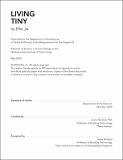| dc.contributor.advisor | Leslie Norford. | en_US |
| dc.contributor.author | Jia, Effie. | en_US |
| dc.contributor.other | Massachusetts Institute of Technology. Department of Architecture. | en_US |
| dc.date.accessioned | 2021-03-22T17:04:45Z | |
| dc.date.available | 2021-03-22T17:04:45Z | |
| dc.date.copyright | 2020 | en_US |
| dc.date.issued | 2020 | en_US |
| dc.identifier.uri | https://hdl.handle.net/1721.1/130181 | |
| dc.description | Thesis: S.B. in Art and Design, Massachusetts Institute of Technology, Department of Architecture, May, 2020 | en_US |
| dc.description | Cataloged from student-submitted PDF version of thesis. | en_US |
| dc.description | Includes bibliographical references (pages 59-61). | en_US |
| dc.description.abstract | Living Tiny is a thesis that explores the role of architecture as a tool for designing both the built environment as well as the social realm of living. In a rapidly urbanizing world, the current pattern of city development results in unwanted isolation, expensive housing prices, and unsustainable growth. Can alternative forms of densification produce more appealing economical, social, and environmental results? This thesis proposes a design that builds upon the already existing infrastructure of alleyways and streets of typical urban neighborhoods. Through the implementation of a secondary scale, a new housing typology can emerge that satisfies the needs of the missing middle. Based on case studies of tiny houses and cohousing principles, Living Tiny envisions a two-part system of collective living that involves tiny house accessory dwelling units (ADUs) and communal buildings for shared amenities. Sited in Austin, Texas, the thesis presents its design for Mueller Tower District, a neighborhood featuring mixed-use zoning and a variety of housing typologies. The envisioned community benefits not only from the increased affordability and sustainability of living, but also from a greater quality of life through social interactions with the people around them. Through thoughtful, human-based architecture, cities of the future can avoid becoming concrete jungles; instead, they can become vibrant communities that support diverse, interconnected populations. | en_US |
| dc.description.statementofresponsibility | by Effie Jia. | en_US |
| dc.format.extent | 61 pages | en_US |
| dc.language.iso | eng | en_US |
| dc.publisher | Massachusetts Institute of Technology | en_US |
| dc.rights | MIT theses may be protected by copyright. Please reuse MIT thesis content according to the MIT Libraries Permissions Policy, which is available through the URL provided. | en_US |
| dc.rights.uri | http://dspace.mit.edu/handle/1721.1/7582 | en_US |
| dc.subject | Architecture. | en_US |
| dc.title | LIVING TINY | en_US |
| dc.type | Thesis | en_US |
| dc.description.degree | S.B. in Art and Design | en_US |
| dc.contributor.department | Massachusetts Institute of Technology. Department of Architecture | en_US |
| dc.identifier.oclc | 1241077701 | en_US |
| dc.description.collection | S.B.inArtandDesign Massachusetts Institute of Technology, Department of Architecture | en_US |
| dspace.imported | 2021-03-22T17:04:15Z | en_US |
| mit.thesis.degree | Bachelor | en_US |
| mit.thesis.department | Arch | en_US |
